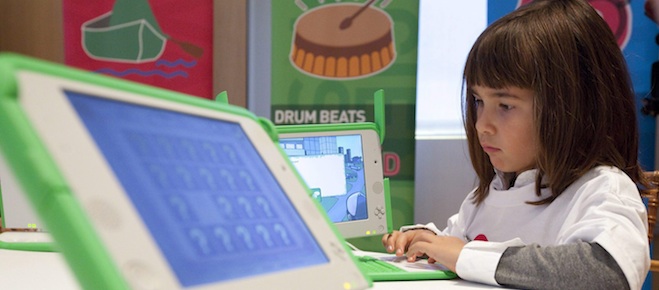Program offers low-cost laptops for young aboriginal students
Two years in, One Laptop Per Child Canada eyes expansion
Sean Kilpatrick/CP
Share

The kindergarten kids who attend Lloyd S. King Elementary School on a reserve near Brantford, Ont. know to pack something extra every Tuesday and Thursday morning: their laptops.
When it’s quiet time on those days, teacher Tammy Sault dims the lights, puts on instrumental music and turns them loose on the kid-friendly green and white machines known as XO laptops. Instantly, the five-year-olds are booting them up and loading programs, solving mazes and identifying patterns.
A girl who has marked her laptop with her name, Emma, points directly at its screen when asked what her favourite thing is about school.
The laptops are here on the Mississaugas of the New Credit First Nation courtesy of One Laptop per Child Canada, a core program of the Belinda Stronach Foundation. The organization partnered with the original One Laptop per Child Foundation in the United States, which has distributed 2.5 million XO laptops in the developing world, to roll out the same rugged, low-cost laptop to young aboriginal students.
Since the launch of OLPC Canada’s pilot phase in September 2010, students at 14 schools in seven provinces and two territories have been given their own XO computers.
“I was really excited about it because not all of the children have access to technology at home,” Sault said.
The kindergarten teacher marvels at how quickly her students have picked up both tech and social skills since they started using the laptops at the beginning of the school year. They instruct one another about how to use different programs and remind each other that the laptop isn’t broken, it just needs to be charged. It has built up their confidence and problem-solving skills, she said.
But not everyone is as excited about the laptop program. Some teachers, not tech-savvy themselves, have expressed no interest in integrating the laptops into their lesson plans. The chat and video functions in particular are labelled a distraction. The laptops sit underused, either at home or at school.
It is one of several reality checks noted by OLPC Canada Director Jennifer Martino. In March, a full outside evaluation of the pilot program will be released. But Martino already knows they need to boost teacher training in the future from her visits to the participating schools.
“In almost every case, I was asked to come back to do additional training.”
A short drive away, at Kawenni:io Elementary School on the Six Nations of the Grand River, students in a mix of running shoes and moccasins recite the Thanksgiving Address in Cayuga and Mohawk to begin the school day.
Here, the biggest controversy over the laptops has been around language. The private school was formed in 1985 as a institution where students could learn the languages of their ancestors. But the language of instruction on the laptops is English.
Kindergarten teacher Esenogwas Hill remembers the initial rollout period as “a frustration”: kids who dropped the laptops burst into tears, thinking they had broken them. They asked her questions about them that she couldn’t answer. Then there were the parents who wanted to know why the laptops used English. Her solution is enforcing a low-volume rule to limit the oral English.
OLPC Canada responded to the English-language concerns, which were heard at multiple schools, by creating a Cayuga and Inuktitut keyboard. Hill still hopes to get Cayuga recordings installed on the laptops for verbal instructions, but said she supports the laptops in any case.
“I try to use them because the kids love them.”
It takes teacher supervision to ensure the kids are using the XOs for their lessons, and not just for the Paint program. But it can be done. Down the hall from Hill’s classroom, Grade 2 teacher Tesha Emarthle is teaching her students about the different phases of moon, which determine when cultural ceremonies are held, using a program called Moon Activity. Earlier in the school year, she took the students outside with their laptops to photograph trees and label their different parts.
OLPC Canada’s pilot phase comes to end in June, and the organization is in the process of securing funding to go forward. With a growing list of communities asking to take part, Martino said she hopes to double outreach in the next two years.
“Some of the schools have five computers that were donated in 1995, and they were used at that time. Some of them are really, really struggling with just basic access to technology. So when they hear that they could have one laptop for every child in their school? I mean, there are some places that don’t even have a cell phone signal.”
Though the OLPC Foundation has struggled in recent years with the advent of tablets, one advantage the XO still offers is durability. Only a few laptops at each site require repairs during the school year. Nevertheless, OLPC Canada is keeping an open mind about future technology, another area that will be addressed in the March report.
“There are lots of great learning apps that have been developed since the XO laptop came out. We’re certainly free to make those decisions, and be flexible, depending on the needs of the communities,” Martino said.
Back at Lloyd S. King Elementary School, special education teacher Carla Miller is sure about one thing: the device itself doesn’t matter as much as the learning opportunities it provides in a changing world.
“It’s so important. It’s where everything’s heading,” she said. “May as well get them started now.”